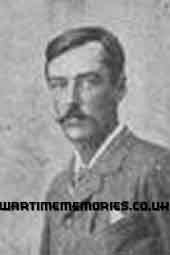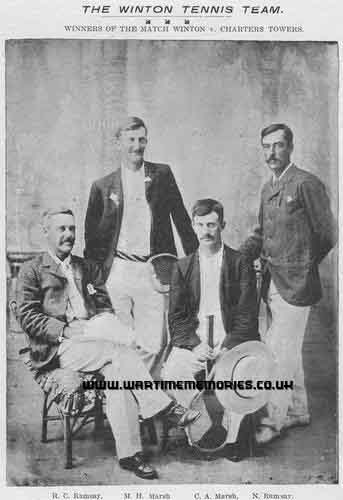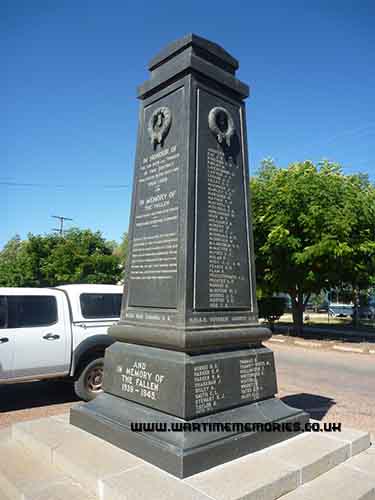Additions will be checked before being published on the website and where possible will be forwarded to the person who submitted the original entries. Your contact details will not be forwarded, but they can send a reply via this messaging system.
please scroll down to send a message
2nd Lt. Norman Ramsay
British Army 16th Battalion Rifle Brigade (Prince Consort's Own)
from:Howletts, Bekesbourne or Ickham, Kent
(d.3rd Sep 1916)
Norman Ramsay 1869–1916 was the 12th child of pioneer Queensland grazier, politician and treasurer Robert Burnett Ramsay and his wife Margaret Cruickshank, Norman Ramsay was born in Queensland on 14 August 1869. Although the details are hazy, it seems that he first went to school in Queensland but was later sent to Glyngarth Preparatory School in England prior to going to Harrow in September 1884 for his secondary education. Like his elder brothers, he was a fine sportsman who excelled at almost every game he played, and was particularly good at football and cricket. By all accounts, he was also a crackshot with both rifle and shotgun, a fine polo player, a good tennis player, and a competent jockey.
In 1888, Norman returned from England to Queensland with his brother Douglas to work for their elder brothers Frank and Bob on the Darling Downs and around Winton. Another brother, Lauderdale, joined them in 1893. Their father, in partnership with the well-known Queensland pastoralist and politician Sir Arthur Hodgson, owned Eton Vale on the Darling Downs but had retired to England; and Frank and Bob, together with Sir Arthur’s son Edward, had bought Oondooroo Station near Winton in 1886.
In 1894, with a view to giving them a capital base, Robert Ramsay bought three 1/12 shares of Oondooroo from Frank and Bob for Lauderdale, Douglas and Norman. Thus was born the famous pastoral firm of Ramsay Bros. & Hodgson, which, some years after the premature death of Edward Hodgson in July 1896, grew to be one of the largest sheep producers in the world. Indeed, in response to a tenuous claim about an unnamed farmer in the USA, 'The Western Champion and General Advertiser' dated 9 October 1905 echoed the 'North Queensland Register' in saying that the Ramsay Bros. would, with a good season or two, “give the American a shaking for the title of biggest sheepfarmers in the worldâ€.
Details of Norman’s movements between 1888 and 1905 are not known. However, it’s known that, as Ramsay Bros. & Hodgson’s pastoral empire expanded, he was at different times manager or acting manager of Oondooroo, Elderslie, Charlotte Plains and Burleigh stations while his elder brothers Frank and Bob remained the prime movers in the Ramsay brothers’ business dealings. Often, Norman and his four brothers would fill in for each other when one or more of them went on holiday. Back then of course, a typical holiday entailed a trip to the home country, and would last at least six months.
Norman spent many years in and around Winton in far-west Queensland, and a couple of years on Bogunda Station at Prairie near Hughenden between 1905 and 1907. It’s clear from everything that has been written and said about him that, like his brothers, he was well liked and highly regarded. Even though he never married, he was affable and popular with women despite suffering for many years from neuralgia, a disorder of the trigeminal nerve that causes frequent and intense pain in the face. Unlike Frank and Bob who seemed to be comfortable in their own company, Norman appeared at times to hanker after the hustle and bustle of city life. To that end, he moved to Sydney in about 1907 and then, with his brother Douglas, moved back to England in 1910 to join their widowed father Robert, their elder brother Frank who had retired two years earlier, and their three surviving sisters, all of whom were living in or near Bekesbourne in Kent.
Norman was still in England when war broke out in 1914. Deeply patriotic to King and country, he enlisted into the British Army even though he was by then 45. At his age and with his wide-ranging experience of life and people management, he could reasonably have asked to be a commissioned officer immediately. Citing inexperience in military matters though, he signed on as a private in the Sportman’s Battalion in October 1914. In October 1915, he transferred to the 16th Battalion Rifle Brigade, part of the Prince Consort’s Own Rifle Regiment that had been formed in 1800 as an “experimental corps of riflemen to provide sharpshooters, scouts and skirmishersâ€, and was immediately promoted to 2nd.-lieutenant.
With his considerable experience as a crackshot in Queensland, Norman was surely a perfect fit for such a regiment. After military training at a number of military camps in England including Hursley Park, Aldershot and Witley Camp, Norman sailed from England to Le Havre on 8 March 1916 en route to the battle front in France.
After a short time at Blaringhem, and alongside soldiers of the Royal Sussex Regiment, Norman and his fellow soldiers of the 16th. Rifle Brigade were reportedly involved in heavy fighting near Richbourg l'Avoue on 16 June 1916. A precursor to the Battle of the Somme, Richbourg was planned as a diversionary action but was actually so bloody that it should perhaps be regarded as the first of the officially designated battles of the Somme.
On 3 September, while reconnoitering German trenches from ‘no man’s land’ during one of the many other battles of the Somme, he was killed by the enemy. The details of exactly how he died or where he was at the time are not known. Sadly, he was one of many thousands of soldiers who died in the Somme but have no known grave. His name though lives on in numerous places including on memorials in Winton and Cambooya in Queensland, in St. Peter's Church in Bekesbourne in Kent, and at Thiepval in France


